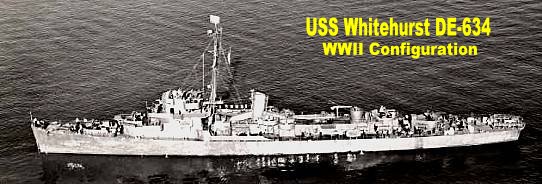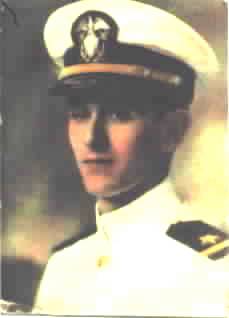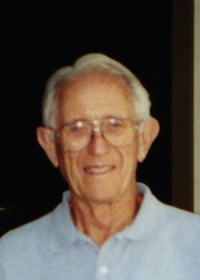
|
Syd Calish |
|
|
First Engineering Officer of the Whitehurst |
|
|
|
|
|
Ensign Syd Calish, 1942 |
Syd Calish 2000 |
|
I grew up in Buffalo, NY, and there the depression was tough
although myfather had work
through most of it. My mother died in 1929 when I was eight and my brother was only 6 months old so my father
spent most of his time and energy on the baby. Thus, we were not close until
after I graduated from Cal in 1941. In 1936, my father moved to Long
Beach, CA to work for a relative and I went to Rockville Center, Long
Island to finish high school living with an aunt and uncle and a cousin who
was a year younger than I. After graduating from South Side High School
in June 1937 I went to Long Beach to join my family. I did not get to the
Bay Area until 1938 so I can't say much about the depression. After I
went to work for Chevron in late 1945 I heard a lot about those years and
how Chevron (then Standard Oil of California) had a work sharing plan
that kept as many people as possible on the payroll. That's something
they would not do today with the emphasis on shareholder return. I attended the University of
California in Berkeley, graduating with a BA in Chemistry in May 1941. I knew Andy Foreman [for whom the USS Foreman (DE-633) is named] at Cal as we were classmates but
in different curricula. I can't remember anything special about Andy
Foreman except to be surprised at his death.
I should have gotten a BS but could not do a required lab course as I was working at two jobs while going
to school. Almost as soon as I graduated from Cal, my father and
brother returned East to wind up in Boston. I stayed in the Bay Area after
that. I then went to work for the Fuller Paint Co. in San Francisco as a
paint technologist, but also signed up for the V-7 program in the
Navy. I had always wanted to go Navy and actually wanted to attend the
Naval Academy. My father never served in the military, I believe he was
medically exempt with a heart condition although he lived to be 76. He never
gave me any advice when I signed up for V-7, it was better than being
drafted. Immediately following Pearl Harbor I received orders to
report to the Naval Academy on January 5, 1942 for four months training as
an Engineering Officer. It was a memorable experience. At
graduation I was commissioned an Ensign and was ordered to Navy Diesel School
at Cornell University for four more months. That was also a memorable
summer as we were the last class to have absolute freedom after hours and
on weekends. Subsequent classes were more regimented and restricted. I
then had duty on two diesel powered mine sweepers until April 1943 when I
was ordered to the Sub Chaser Training Center in Miami, FL. I was in the Atlantic on the mine sweepers. The first one
was only 98 feet long and built on a tuna boat wooden hull. It worked
out of Staten Island and we swept for mines out the busy NY Harbor Channel
as far south as Atlantic City. This was through the winter and it was
rough and cold. The next ship was a 220 foot mine sweeper but other than drills
we never swept for mines but were used as convoy escort out of
Norfolk to the Caribbean ports. We got as far as Recife, Brazil. I was
supposed to be the Engineering Officer but there was a Warrant Machinist on
board and the Captain was a mustang ex-warrant and would not let me do
my job but had me standing deck watches. That was OK by me for the
experience. I was only aboard for one round trip before I was sent to SCTC,
Miami. Four more months plus two at the GE plant in Syracuse to
train on the turbo-electric power plants to be used in the Buckley class
DE's plus one more at the Navy Boiler School in Philadelphia. I think most
of the prospective Eng. Off. from SCTC attended Boiler School. The GE school in Syracuse was like an engineering lab course in any school in
the Navy or vocational school.
It was taught by both Navy and GE personnel and had lots of hands on work. But it was only 9 to 5, 5 days a week
and I had relatives in Syracuse.
Back to Miami to wait for assignment as the Engineer Officer of a new DE. I got the Whitehurst back home
in San Francisco and reported there in September 1943. The commissioning ceremony was very simple as there were
many of themgoing on at the shipyard and not many of the ships company
had their families with them. LCDR James R. Grey, USN accepted the
ship as its commanding officer. I don't even remember the details or
whether there was a band present. I do not have a copy of the program if
there even was a formal one. Not everyone aboard the 634 got sick the first time we went
out the Gate, but I sure did. I got seasick every time we went to sea
after being in port a while. It took about 36 hours to get my sea legs and
then it was OK. When it was really rough I was too scared to get sick
such as the time we went through a typhoon. Actually the first shakedown
cruise to San Diego was as bad as the typhoon. The DE was not a very stable platform
but it could tolerate rolls of over 45 degrees. We had some problem drinkers on the Whitehurst but they were
usually the older enlisted men. We had one very senior Chief Radioman
who filtered an aftershave through bread for his kicks. I don't think we had
any officers that drank while aboard ship but our ASW Officer (he died
when we got hit by the Kamikaze) drank a whole case of beer at one sitting. Stewards Mates were taken for granted in the Wardroom and
they were all involved at mealtimes. They were usually a good bunch of
guys and I believe were treated well. Some of them were excellent
cooks. Most of them had GQ stations other than in the Wardroom and were on
gun crews, ammunition handlers and even in damage control. The
Whitehurst had a silver plate set I think was monogrammed. I much preferred the DE duty and would have liked an even
bigger ship. Steam was much easier on the Black Gang than diesel because
there was less preventive maintenance. There are few moving elements
to a boiler and turbine generators and motors go round and round, not up
and down so there is far less
wear and tear. Some of the diesel DE's has four 16 cylinder engines and two eight cylinder generator sets,
that’s 82 cylinders to inspect and maintain. The Black Gangs on the
diesel DE's had far less shore leave when in port than we did. Then there is
the noise, vibration and exhaust stink of diesels. Guess which one I
preferred. When not at GQ, the engineer officer worked during the day
and slept at night. As Engineering Officer I rarely stood deck watches
although I qualified to do so while on the smaller mine sweepers. The daily routine for an E. O. was quite boring unless there was a problem or
we were at GQ or in a drill. Every morning, first thing I got reports from
the Oil King as to the fuel supply and fresh water available. I then
reported this to the Captain. I don’t remember that the Oil King had a special compartment
although the fuel manifold was in a special area. He had an array of
valves and pumps to use for fuel transfer. The Oil King was usually one of
the more experienced Fireman 1/c and was supervised and trained on
the Whitehurst by the Chief Water Tender, an old hand. I made daily inspections of the engineering spaces and
talked to the various leading ratings about their duties or problems. When underway I usually went into all the engineering spaces about twice a
day, sometimes more. This includes areas other than the engine and fire
rooms such as after steering, the gyro room, the auxiliary and evaporator
flats, etc. Engine and fire room entry was by hatches through the main
deck—each was separate and there were no doors between them for safety and
hull integrity reasons. The Engineering Office on the Whitehurst was on the main deck about amidships and just forward of a small machine shop. It was home to the Yeoman on my staff and I used it to keep up with paperwork. There was quite a bit of paper work including reports of rating progress of the Black Gang and other educational activity (The crew usually
did 4 on and 8 off and during one of the 8 off did some studying and we
had classes for rate advancement.). There was always some maintenance
going on. And then there were the drills.
When gunnery practice was going on, we were usually at GQ
and some training was undertaken at most duty stations. There were
more people assigned to the "E" division than were required at
GQ so some of my men were in damage control, some manned 20 mm guns, some were in
ammunition parties, and my Yeoman was the sound powered phone talker on
the flying bridge. My GQ station was the Forward Engine Room which was standard practice for DE's and DD's.
The GQ station of the Asst. E.
O. was the after engine room.
This was a lucky spot at Okinawa.
There was a talker on the sound powered phones during GQ but routine engine
changes were done by the ER telegraph. When at GQ we did 4 on and 4 off but most of the time the 4
off was spent close by. That is for prolonged periods. At full GQ we were
at station all the time with the cooks and stewards bringing food and
drink to the stations. In many of the areas there were blowers forcing
air circulation (not cooled) so they were tolerable. The worst times were
when the ship was quieted so it could minimize noise for ASW purposes.
Also when escorting a very slow convoy with a following wind. I never went to Damage Control School as that was the duty
of the First Lieutenant. While some of the Black Gang were assigned to
Damage Control parties at GQ, these billets were also the responsibility of
the First Lieutenant. You must remember that only about 10-15% of the
time at sea were we at GQ so most of the duty was quite monotonous. Don't remember any leaky steam gaskets from November 1943
until July of 1945. Our biggest problem was the evaporators. The only mechanical problem I recall is when we hit a submerged log entering Espiritu
Santo and bent a propeller. We had to be dry docked for repairs. Most of the time we used both boilers. Maybe because we were
always in what was considered combat zones. In port, when cleaning
firesides while at anchor, we would secure one boiler but rarely when
underway. Boiler cleaning was done only at anchor or dockside. If I remember
we tried to do it about every six months. So there was no decision to switch from one fire room/engine room to the other. It was possible to
use only one boiler to feed steam to both engine rooms and the ship could
probably make about 15 knots, maximum, but anything more required
both boilers. Each main turbine-generator served one main motor that was
directly connected to one of the two propellers. The Black Gang was responsible for making dockside
connections. It usually took about 3 hours to get steam up but it could be
done in one if necessary. If we were using our own generators for
electricity, one boiler was already on line and we could get underway
immediately while bringing the other boiler up to steam. That's one advantage
of diesel (or later gas turbines) as it could give instant start. Outside of Hawaii and possibly a short visit to Australia
there were few "beautiful and lush" tropical islands because we
rarely got ashore and when we did it was to pick up mail or straight to the
Officers Club. Most of my impressions were from off-shore while at anchor or
cruising by. There were books available to both officers and crew. I
think the USO or the Red Cross made them available at major ports of call. I
know I tried to read War and Peace but never could finish it. I don't
remember too many magazines. I can't remember the exact location of the chart house or if
there was anything more than a closet to hold all the charts. I expect
that the QM's did their work in the CIC area. The O2 level on the 634
was the standard arrangement for the Buckley class DEs. When the Commodore was aboard the CO used the sea cabin and the
boss used the CO's. I have a publication entitled "Destroyer
Escorts of World War II" that shows that the so-called Chart House was the
same space as CIC and was aft of the bridge.
I remember very little about either Cdr. Thorwall or Hawes (Most often he was called Fearless
Freddie. The crew picked it up from the officers.) except that they were a
pain in the neck when they were aboard the Whitehurst. It was too crowded to
accommodate them and staff. I don't even remember too many times when we
operated with the other ships of CortDiv 40. We always seemed to be
with strangers. I worked for Chevron for 36 years in research and in the
home office as an engineer mainly in the field of lubricants and
lubrication. After retirement in late 1981, I consulted for about 7 years but
got tired of airports and travel to the East and Mid-West in bad weather. I have been to Japan only once and that as a civilian while
I was consulting. I had a Navy contract and after a meeting in
Australia my wife and I went to Bangkok, Singapore, Hong Kong and Tokyo.
I think the Japanese today are just like most of the Americans of the
same generation —they have little recognition of what it was like during the
WWII. They are more concerned, however, because they suffered
destruction and defeat, or at least their parents or grandparents did. We have lived in St. Helena for 20 years now and it has
changed greatly. It was a charming, small farming community with not a great
deal of big money here. A city of about 3500. Now it is approaching 6000
and lots of wealth dominates the area. It is a tourist destination so
the Main Street is a zoo on the weekends and all summer long. To Contact Author, Syd Calish |
|
WWII
Era | Korea War &
'50s | Viet Nam & 60s |
Reunions |
All Links Page
Search & Rescue
Memorial | Poetry | Enemy Below | Taps List | Photos/Armament | History | Crews Index | Home

